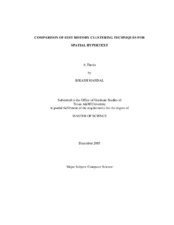| dc.description.abstract | History mechanisms available in hypertext systems allow access to past user interactions
with the system. This helps users evaluate past work and learn from past activity. It also
allows systems identify usage patterns and potentially predict behaviors with the system.
Thus, recording history is useful to both the system and the user.
Various tools and techniques have been developed to group and annotate history in
Visual Knowledge Builder (VKB). But the problem with these tools is that the
operations are performed manually. For a large VKB history growing over a long period
of time, performing grouping operations using such tools is difficult and time
consuming. This thesis examines various methods to analyze VKB history in order to
automatically group/cluster all the user events in this history.
In this thesis, three different approaches are compared. The first approach is a pattern
matching approach identifying repeated patterns of edit events in the history. The second
approach is a rule-based approach that uses simple rules, such as group all consecutive
events on a single object. The third approach uses hierarchical agglomerative clustering
(HAC) where edits are grouped based on a function of edit time and edit location.
The contributions of this thesis work are: (a) developing tools to automatically cluster
large VKB history using these approaches, (b) analyzing performance of each approach in order to determine their relative strengths and weaknesses, and (c) answering the
question, how well do the automatic clustering approaches perform by comparing the
results obtained from this automatic tool with that obtained from the manual grouping
performed by actual users on a same set of VKB history.
Results obtained from this thesis work show that the rule-based approach performs the
best in that it best matches human-defined groups and generates the fewest number of
groups. The hierarchic agglomerative clustering approach is in between the other two
approaches with regards to identifying human-defined groups. The pattern-matching
approach generates many potential groups but only a few matches with those generated
by actual VKB users. | en |


